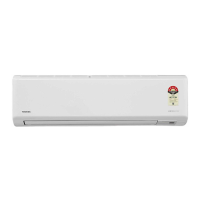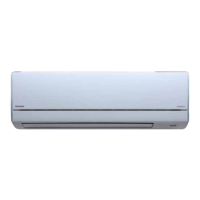
Do you have a question about the Toshiba RAS-22N3AV-E and is the answer not in the manual?
| Category | Air Conditioner |
|---|---|
| Type | Split System |
| Cooling Capacity | 2.2 kW |
| Heating Capacity | 2.5 kW |
| Energy Efficiency Ratio (EER) | 3.21 |
| Coefficient of Performance (COP) | 3.61 |
| Power Supply | 220-240V, 50Hz |
| Refrigerant | R410A |
| Indoor Unit Dimensions (W x H x D) | 798 x 293 x 230 mm |
| Outdoor Unit Dimensions (W x H x D) | 660 x 530 x 240 mm |
| Weight (Indoor Unit) | 9 kg |
| Noise Level (Outdoor) | 50 dB(A) |
General safety precautions for operating and installing the air conditioner.
Specific warnings and guidelines for safe installation procedures.
Additional cautions and recommendations for installation work.
Detailed technical specifications for indoor and outdoor units.
Graphs showing compressor speed vs. current and capacity ratio vs. temperature.
Safety precautions and guidelines for handling R410A during installation and servicing.
Guidelines for the proper installation of refrigerant piping systems.
Details on recommended copper pipes, joints, and their specifications.
Procedures and precautions for cutting, deburring, and flaring piping materials.
Steps and warnings for correctly connecting flare fittings and tightening torque.
Details specific tools needed for R410A systems and their interchangeability.
Procedure for recharging refrigerant into the air conditioner system.
Materials, flux, and procedures for brazing refrigerant pipes.
Detailed diagrams showing dimensions and parts of the indoor unit.
Diagrams showing dimensions and components of the outdoor unit.
Comprehensive wiring diagram for both indoor and outdoor units.
Specifications of electrical parts for the indoor unit.
Specifications of electrical parts for the outdoor unit.
Schematic showing refrigerant flow for RAS-18N3KVR-E / RAS-18N3AV-E models.
Control block diagram for the indoor unit and remote controller functions.
Control block diagram for the outdoor unit's inverter assembly.
Overview of capacity control, DC motor usage, and unit control logic.
Description of basic operation, cooling, heating, AUTO, and DRY modes.
How the unit's operation is controlled via remote, indoor, and outdoor units.
Details on how cooling and heating modes are activated and controlled.
Explanation of automatic mode selection based on room temperature.
How the unit operates in DRY mode for dehumidification.
Control of the indoor fan motor speed in different operating modes.
Control of the outdoor fan motor speed based on conditions.
How the unit adjusts capacity and protects components.
Procedure for removing frost from the outdoor heat exchanger during heating.
Control of louvre position, direction, and swing for air flow.
Energy-saving operation mode.
Function to automatically restart the unit after power failure.
Information on the remote controller's buttons and indicators.
Guidelines for installing the indoor unit.
Guidelines for installing the outdoor unit of the air conditioner.
How to perform a gas leak test on the refrigerant connections.
How to select remote control A or B for multiple units in the same room.
Initial checks for power supply and voltage confirmation.
Methods for initial judgment of potential troubles.
Interpreting flashing LED indicators for self-diagnosis.
Using the remote controller for self-diagnosis and error code lookup.
Troubleshooting steps based on specific symptoms observed with the unit.
Diagnosing issues related to wiring between indoor and outdoor units.
Troubleshooting specific error codes related to wiring and sensors.
Procedures for checking specific components like the air purifier.
Troubleshooting steps specific to the outdoor unit.
Methods for checking major components like P.C. boards and sensors.
Procedure to determine if the outdoor fan motor is functioning correctly.
Procedures for replacing major components within the indoor unit.
Procedures for replacing major components within the outdoor unit.
Exploded view and parts list for the indoor unit components.
Detailed exploded diagrams of the indoor unit assembly.
Exploded view and parts list for the outdoor unit components.
Layout diagram of the outdoor unit's P.C. board.
Layout diagram of the outdoor unit's P.C. board.









